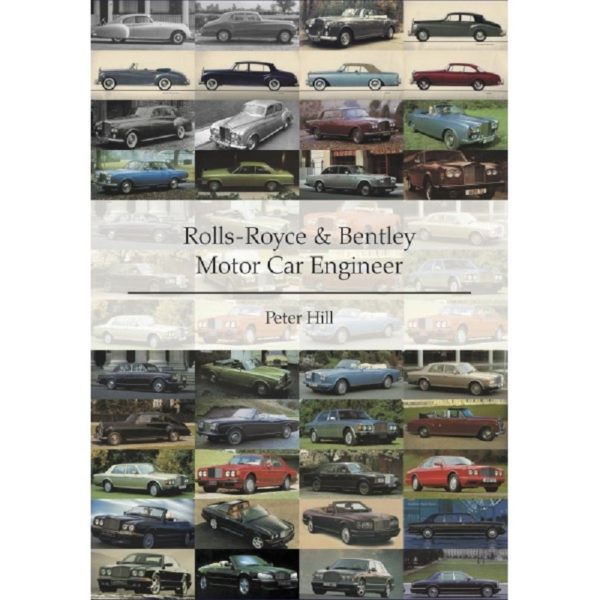
by Peter Hill
2020 review by Prof. Peter Fawcett
Like his father before him, author Peter Hill spent his entire career from apprentice to senior engineer at the Royce Crewe factory, so this monumental opus is, and no doubt will remain for some time, as a significant contribution to the annals of automotive history.
The highly-detailed but eminently-readable text takes us from Hill’s apprenticeship to retirement, offering a unique insight into how Rolls-Royce made every effort via a rigorous developmental regime to maintain the validity of their claim to be the ‘Best Car in the World’.
To enthusiasts for the marque no doubt imbued with the hubristic Royce ‘mythology’, Hill’s meticulous accounts of building and rigorously testing prototypes and modifications to the cars’ specification, are remarkable in their ‘warts and all’ revelations, for the failures as well as the outstanding successes are chronicled here where Hill manifests a rare ability to present complex engineering concepts with notably lucid prose. Nevertheless owners of Shadows and their successors will regret that Crewe eschewed any attempts at rust prevention in their rot-prone monocoques.
Since the adoption of Hispano-Suiza’s gearbox-driven brake servo, Rolls-Royce successfully produced under licence General Motors’ independent front suspension and automatic transmissions, and elements of Citroën’s incomparable suspension, so it seems odd that a similar strategy was not applied to adapting existing well-proven air conditioning systems. Indeed, the ‘jury-rigged’ testing apparatus evolved on a very limited budget at Crewe for an in-house prototype a/c system seemed distinctly ‘Heath Robinson’.
Of particular interest is how the FB 60 overhead inlet/side exhaust four-litre engine was developed for varied uses and how Crewe perceived its application to lesser marques as a route to widening accessibility to Bentley ownership. In the event, the unpopular Van den Plas Princess ‘R’, which consistently failed to reach its sales targets, was the outcome, no doubt accounting for a prototype Bentley version’s (with appropriate grille displacing the VdP item) never meeting production. FB 60 in highly-tuned form also graced a similarly rejected widened Austin-Healey monocoque prototype with performance equal to Jaguar’s E-Type. A Humber Super Snipe was also equipped with the FB 60 engine but the Chrysler takeover of Rootes effectively killed what Hill perceived to be a much more acceptable installation than in the Princess ‘R’.
Crewe spent lavishly on acquiring cars from other manufacturers for detailed analysis, after which Hill as a suspension specialist spent much time designing and developing sophisticated suspension systems which were rigorously tested worldwide; nevertheless much testing of suspension and braking developments took place on nearby Cheshire country lanes at speeds well in excess of 120 mph despite a blanket 70 mph speed limit, and without, it seems, warning local residents! Of real interest are Hill’s briefing notes for suspension modifications, how such were fabricated, installed, tested and then appraised in a meticulous post mortem. There is a hint of ad hocism here; if it breaks, make it bigger! Nevertheless, it was clear that Jaguar with their monocoque Mark 10 and XJ6 with independent rear suspension and disc brakes had achieved standards of ride, handling and refinement superior to Crewe’s efforts. The conclusion must be that Browns Lane had better engineers and presumably a more efficient system of evaluation.
Although immersed in the arcane Royce culture since birth, nevertheless, the author is highly critical of Crewe’s reluctance to develop promising innovative and progressive prototypes to production; senior management at Crewe comes in for severe criticism, especially those with a provenance in sales!
Inevitably, automobile engineering dominates this work, but it is regrettable that Crewe’s many styling exercises receive little or no mention; moreover, illustrations of such surely would have considerably enhanced the publication. A work of such historical significance arguably requires an index, and it is unfortunate that frequent typographical and grammatical errors appear in stark contrast to such erudite content and clear layout.
But these are very minor criticisms of an impressively monumental and unique oeuvre which every owner of Crewe products or those with an interest in ‘The Best Car in the World’ and ‘The Silent Sports Car’ should have in their libraries, for at a mere £45 it is remarkable value. It is also an accessible ‘primer’ in mechanical engineering for laymen such as this reviewer!
Publisher: Peter R. Hill (2019)
Price: £45 (UK RRP)
Description: Hardback, A4 format on art paper, 543 pages.
ISBN: 978-1-916052406
Available from: YPD Books, Layerthorpe, York YO 31 7ZQ. Tel: (01904) 431213.
ypdbooks.com/business/2113-rolls-royce-bentley-motor-car-engineer-YPD02386.html







Leave a Comment